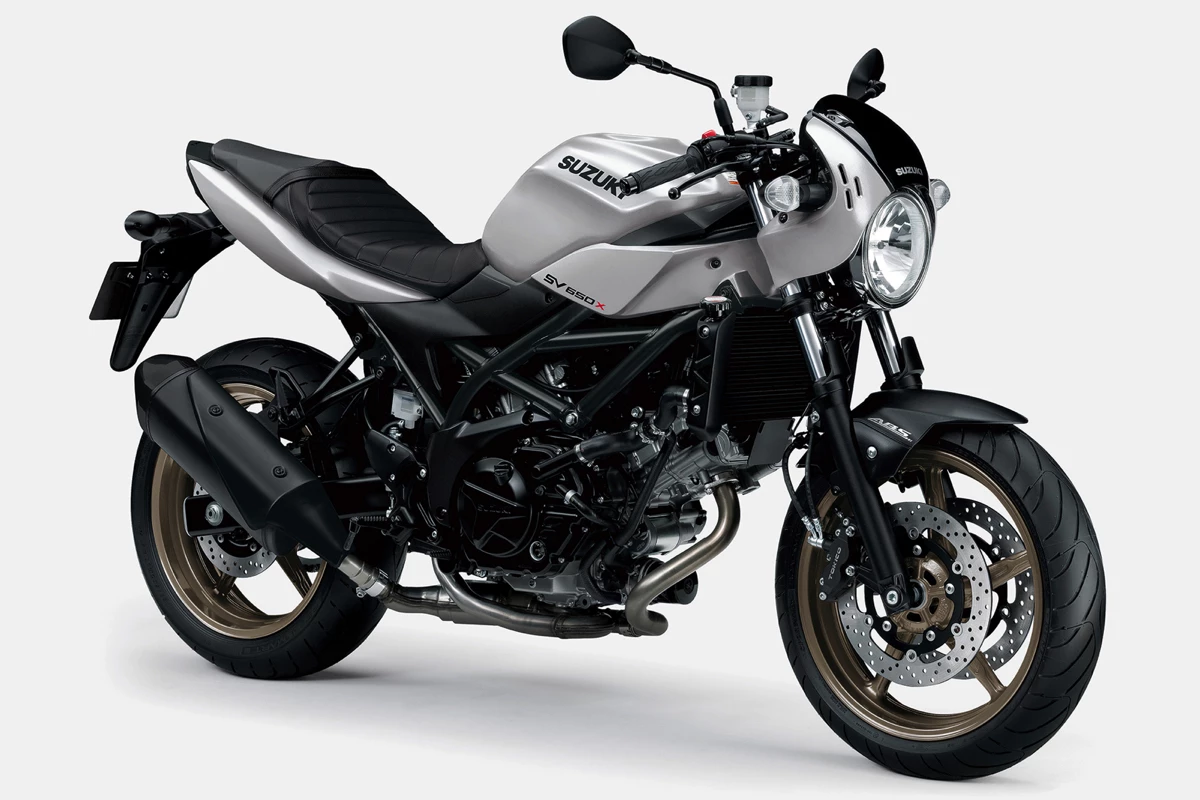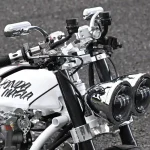In recent years, one of the most popular styles worldwide is the "cafe racer," which combines a retro atmosphere with a sporty style. In particular, in 2024, Yamaha's "XSR900GP," which is reminiscent of the old WGP (World Road Racing Championship) machines and is attracting attention as a new type of cafe racer, will be released. The lineup is becoming more and more complete.
However, even though it is called a cafe racer, there are differences in style and equipment, for example, some models have a front cowl and some do not. In addition, there is a similar model with a classical atmosphere called "naked," but it is deliberately distinguished from cafe racers.
So what kind of bike is this cafe racer? If we look at its origins, it can be said that it is the original of the "racer replica" popular in the 1980s and 1990s and the current "super sports." Let's look at the basic characteristics and roots of the cafe racer, including the reasons for this.
- What models of Japanese-made cafe racer motorcycles are there?
- Retro and sporty styles are the common denominator.
- Its roots lie in the custom motorcycles of street racers that were popular in the 1960s.
- Why there are cowl and non-cowl versions
- Differences from the naked motorcycle
- Why it's the origin of racer replicas
What models of Japanese-made cafe racer motorcycles are there?
First, let's take Japanese-made motorcycles as an example and introduce what cafe racer models are available for purchase as new (as of July 2024).
[Honda].
Hawk 11."
With a 1082cc in-line 2-cylinder engine/separate handlebars/front cowl
CB1000R
Without a 998cc inline 4-cylinder engine/bar handle/front cowl
CB650R
Without 648cc, in-line 4-cylinder/pipe handlebar/front cowl
CB250R
Without 249cc, single cylinder/pipe handlebar/front cowl
CB125R
Without 124cc, single cylinder/pipe handlebar/front cowl

Honda Hawk 11

Honda CB1000R

Honda CB650R (Photo: E-clutch Spec.)

Honda CB250R

Honda CB125
Yamaha
XSR900GP
With 888cc, in-line 3-cylinder/separate handlebar/front cowl
XSR900
Without 888cc, in-line 3-cylinder/pipe handlebar/front cowl
XSR700
Without 688cc, in-line 2-cylinder/pipe handlebar/front cowl
XSR125
Without 124cc, single cylinder/pipe handlebar/front cowl

Yamaha XSR900GP

Yamaha XSR900

Yamaha XSR700

Yamaha XSR125
Kawasaki
Z900RS Cafe.
With 948cc, in-line two-cylinder/pipe handlebar/front cowl

Kawasaki Z900RS Cafe
Suzuki]
SV650X
With 645cc, 90° V-twin (2-cylinder)/separate handlebar/front cowl

Suzuki SV650X
Retro and sporty styles are the common denominator.
Under each model name, we have included the engine type, displacement, and features related to the equipment as a cafe racer. As you can see, some have a front cowl some don't, and some have bar handlebars and some have separate handlebars.
As mentioned above, what these have in common is that they exude a retro atmosphere while also having a sporty form and ride.
For example, Honda's Hawk 11 uses a front cowl made of FRP called a rocket cowl. Kawasaki's Z900RS Cafe and Suzuki's SV650X also have front cowls.

The rocket cowl on the front of the Hawk 11
By the way, although the Yamaha XSR900GP has a cowl, it has a slightly different image from other models, but for reasons that will be explained later, we are counting it as a cafe racer here.
Going back to the topic, the Hawk 11, XSR900GP, and SV650X use separate handlebars. The rest are equipped with pipe handlebars. However, even for bar-type models, the handlebar position is set relatively low. As with the separate handlebar models, the common point is that the riding position is slightly leaning forward and sporty.
Its roots lie in the custom motorcycles of street racers that were popular in the 1960s.
The reason why models called cafe racers feature such equipment has to do with their origins. Originally, cafe racer referred to a style of custom bikes that originated in the UK in the 1960s, and this model incorporates those features.
At the time in the UK, there were many young people known as "rockers" who would gather at cafes almost every night and enjoy road races from there.
These young people were characterized by wearing leather jackets and pants, and riding custom motorcycles. Moreover, many of the bikes they rode were said to have been modified to imitate the style of the racing machines of the time.
Many of the base vehicles were models from British manufacturers such as Triumph, BSA, and Norton, which were very active in the racing scene at the time. Young people at the time who enjoyed the speed and thrill of motorcycles in road races admired the dynamic racing machines in world motorcycle championship series such as the Isle of Man TT race, and began to customize their favorite motorcycles based on them.
The name cafe racer originally referred to the young people who gathered at these cafes to race on public roads, but it is said that it eventually came to refer to their favorite motorcycles as well.

Cafe racers are a custom style that was popular in the UK in the 1960s. In Japan, custom motorcycles based on the Yamaha SR400 and other models have long been popular as street customs.
Why there are cowl and non-cowl versions
The cafe racer style has these roots. The main modifications at the time were low and narrow handlebars, such as separate or flat bar types, and rear steps that move the steps further back.
The seats were also single-type seats that allowed the rider to sit towards the rear of the bike, resulting in a riding position with the upper body leaning forward.
The reason why many cafe racers don't have cowls is because most bikes at the time were cowl-less. Many styles were like a sporty version of what we would call naked today.
However, there were also custom motorcycles with original front cowls, and these also seem to have been popular.
And for these front cowlings, the mainstream design was a streamlined style that imitated the racing machines of the time. This is the kind of cowling used on the Hawk 11. It came to be nicknamed the rocket cowling, probably because its rounded shape with a protruding tip resembles a rocket.
In other words, the reason why modern cafe racers come with and without a front cowl is because both specifications were called cafe racers back then.
Differences from the naked motorcycle
This custom style then spread to North America, Japan, and other countries, where many custom builders produced their own original machines. It spread worldwide, and the style known as the cafe racer was established.
Motorcycle manufacturers both in Japan and abroad caught on to this trend and released commercial vehicles incorporating the cafe racer style. One example of this is the Honda GB250 Clubman, which was released in 1983.

Honda GB250 Clubman (1983)
Furthermore, in the 2000s, the "neo-classic" style, which combines a classical style with a modern taste, became very popular. Various types of commercial motorcycles inspired by famous motorcycles of the past appeared.
As part of this trend, cafe racers also became popular as a style with a particularly sporty atmosphere within the neo-classic genre, and today there is a wide lineup of commercial vehicles.
Thus, cafe racers originally originated as custom motorcycles. Although they share a retro atmosphere, their origins are different from so-called naked models.
For example, Kawasaki's "Z900RS". Since its release in 2017, it has been a huge hit model that has received particularly strong support among large motorcycles, but its roots lie in the 900cc model "900 Super 4", commonly known as the "Z1", which appeared in 1972. By adopting a teardrop-type fuel tank and tail cowl, the Z900RS can be said to be a modern revival of the Z1's style.

Kawasaki Z900RS SE

Kawasaki 900 Super 4 (Also known as Z1)
On the other hand, the Z900RS Cafe is based on the Z900RS and has a cafe racer style. Like the Z900RS, it is equipped with bar handlebars, but while the base Z900RS has a higher type that puts you in an upright position, the Z900RS Cafe has a lower type that puts you in a more forward-leaning position. It also features equipment that incorporates the features of the cafe racer mentioned above, such as a front cowl and a single-style exclusive seat.
In other words, the Z900RS Cafe can be said to be a customized version of the Z900RS by the manufacturer. In the case of Yamaha's XSR900GP, it is also a manufacturer-made customized version equipped with cowling and separate handlebars, based on the pipe handlebars and cowl-less XSR900.

The Z900RS Cafe can be said to be a custom Z900RS done by the manufacturer.
The XSR900GP does not have the rocket cowl of the so-called cafe racer. However, if you consider its origins, it can be said to belong to the same genre. The era of the racing machine it pays homage to has simply shifted from the traditional 1960s and 1970s to the 1980s, but there is no doubt that it follows the formula of a cafe racer.
Why it's the origin of racer replicas
As mentioned above, cafe racers are modeled after racing machines and are similar to the racer replicas that were all the rage from the mid-1980s to the early 1990s, or modern super sports motorcycles.

Racer replicas are similar to cafe racers in that they are modeled after racing machines (pictured is a 1986 Honda NSR250R).
Of course, old cafe racers were not made by manufacturers, but were simply customized by users. But they are the same in that they pay homage to the style of machines that were active in world races such as the WGP. What's more, they are also similar in that motorcycle manufacturers are actively adopting that style and selling it as a commercial motorcycles.
From this perspective, cafe racers can be said to be the forerunners or originators of racer replicas and super sports motorcycles.
Other cafe racer models, such as Triumph's Speed Triple 1200RR and Thruxton RS, and Royal Enfield's Continental GT650, have also been strengthened in recent years by overseas manufacturers (although unfortunately, production of the Thruxton RS will end in 2024).

Triumph Thruxton RS, which will cease production in 2024 (pictured is the Final Edition)

Triumph Speed Triple 1200RR

Royal Enfield Continental GT650
The cafe racer genre is full of attractive models. As mentioned above, the engine displacement ranges from small models such as 125cc mopeds and 250cc light motorcycles to big motorcycles with engine displacements of up to 1200cc, making it appealing for a wide range of riders.
For users who are looking for not only a classic style but also a sporty ride on winding roads, this is a genre that is sure to appeal to many.



